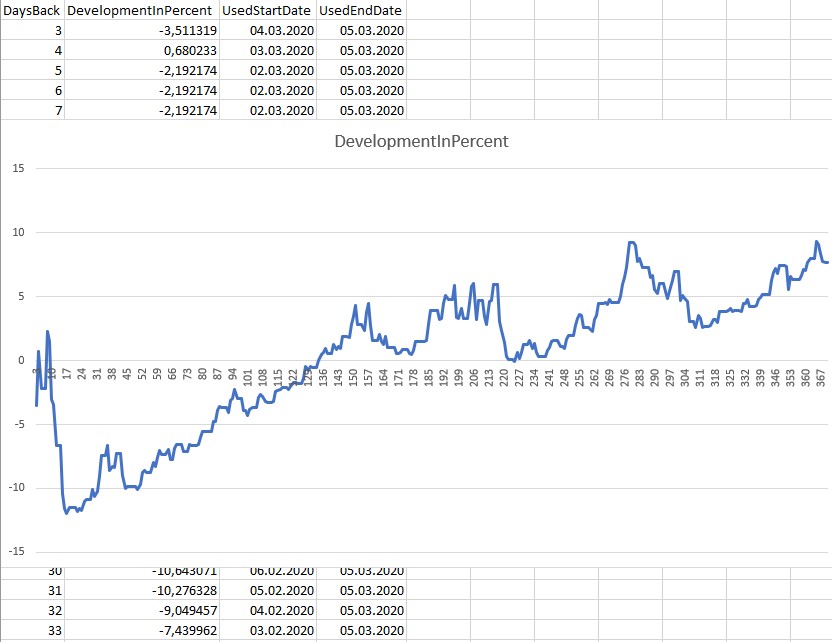Jump to page sections
Here I describe how I calculate the trend for financial products, indices/indexes, etc. It can really be used for any kind of numbers where you want a trend analysis. Incidentally, I originally wrote a version of this to calculate when computer disk storage space in an enterprise would reach 0 on various components/drives.
I use trend-line mathematical analysis of the numbers. This was written by Joakim Borger Svendsen, head of
Svendsen Tech.
Below are examples of analysis now during the tumultous and unusual times in March 2020, when Covid-19 is rampant, also known as the Corona virus.
The VIX fear index, measuring volatility (fluctuations in price), has skyrocketed recently and is at the highest since February 2009 right now on March 6, 2020.
NB! These are simply indicators and based on nothing but math and close rates, so make sure you're aware of that!
It will exaggerate the current trend.
The code I use is open source and published on
GitHub here.
I use financial data from Yahoo. The code works unaltered against it as per 2020-03-06.
Calculate the Trend for the SnP500 Index
Example analysis from March 6, 2020. SnP500 is closed now as I'm writing this at 10 PM / 22:00 GMT. Nasdaq is still kicking, apparently (see below).
PS C:\temp> Get-SnP500Trend -FilePath .\^GSPC.csv
# Close rates back in time.
Date Rate Count
---- ---- -----
2020-02-05 3334.689941 1
2020-02-06 3345.780029 2
2020-02-07 3327.709961 3
2020-02-10 3352.090088 4
2020-02-11 3357.750000 5
2020-02-12 3379.449951 6
2020-02-13 3373.939941 7
2020-02-14 3380.159912 8
2020-02-18 3370.290039 9
2020-02-19 3386.149902 10
2020-02-20 3373.229980 11
2020-02-21 3337.750000 12
2020-02-24 3225.889893 13
2020-02-25 3128.209961 14
2020-02-26 3116.389893 15
2020-02-27 2978.760010 16
2020-02-28 2954.219971 17
2020-03-02 3090.229980 18
2020-03-03 3003.370117 19
2020-03-04 3130.120117 20
2020-03-05 3023.939941 21
# Predictions ahead (-21 for each number for how many predictions ahead).
2020-03-06 3003,129475 22
2020-03-06 2982,264134 23
2020-03-06 2961,357041 24
2020-03-06 2940,417798 25
2020-03-06 2919,453528 26
2020-03-06 2898,469579 27
2020-03-06 2877,470011 28
2020-03-06 2856,457941 29
2020-03-06 2835,435783 30
2020-03-06 2814,405424 31
2020-03-06 2793,368352 32
2020-03-06 2772,325750 33
2020-03-06 2751,278564 34
2020-03-06 2730,227556 35
2020-03-06 2709,173346 36
2020-03-06 2688,116438 37
2020-03-06 2667,057247 38
2020-03-06 2645,996115 39
2020-03-06 2624,933325 40
2020-03-06 2603,869114 41
2020-03-06 2582,803680 42
Calculate the trend for the NASDAQ 100 Composite Index
Here's 50 samples back and 10 predictions ahead (exaggerated trend) for the NASDAQ 100 composite index as of 2020-03-06. The name of the function is misnomered in retrospect (damn retrospect), but I specify the "^NDX" paper, so it handles the NASDAQ data I download from
Yahoo here.
PS C:\temp> Get-SnP500Trend -FilePath .\^NDX.csv -SamplesBackCount 50 -PredictionsAheadCount 10 |
select -Last 30
Date Rate Count
---- ---- -----
2020-02-06 9445.919922 31
2020-02-07 9401.099609 32
2020-02-10 9516.839844 33
2020-02-11 9517.860352 34
2020-02-12 9613.200195 35
2020-02-13 9595.700195 36
2020-02-14 9623.580078 37
2020-02-18 9629.799805 38
2020-02-19 9718.730469 39
2020-02-20 9627.830078 40
2020-02-21 9446.690430 41
2020-02-24 9079.629883 42
2020-02-25 8834.870117 43
2020-02-26 8873.759766 44
2020-02-27 8436.669922 45
2020-02-28 8461.830078 46
2020-03-02 8877.980469 47
2020-03-03 8594.490234 48
2020-03-04 8949.280273 49
2020-03-05 8671.660156 50
# Predictions for NASDAQ start here. -50 for each prediction count ahead.
2020-03-06 8677,729847 51
2020-03-06 8682,548889 52
2020-03-06 8686,256142 53
2020-03-06 8688,972807 54
2020-03-06 8690,804947 55
2020-03-06 8691,845610 56
2020-03-06 8692,176621 57
2020-03-06 8691,870105 58
2020-03-06 8690,989777 59
2020-03-06 8689,592046 60
Visit the aforementioned
GitHub link to get the code and some more information, but the threshold for using the tool is quite high. My apologies. :)
Calculate the Trend for the Dow Jones Index
And here's 30 samples back and 10 predictions ahead for the Dow Jones index as of today.
PS C:\temp> Get-SnP500Trend -FilePath .\^DJI.csv -SamplesBackCount 30 -PredictionsAheadCount 10 |
select -Last 30
Date Rate Count
---- ---- -----
2020-02-06 29379.769531 11
2020-02-07 29102.509766 12
2020-02-10 29276.820313 13
2020-02-11 29276.339844 14
2020-02-12 29551.419922 15
2020-02-13 29423.310547 16
2020-02-14 29398.080078 17
2020-02-18 29232.189453 18
2020-02-19 29348.029297 19
2020-02-20 29219.980469 20
2020-02-21 28992.410156 21
2020-02-24 27960.800781 22
2020-02-25 27081.359375 23
2020-02-26 26957.589844 24
2020-02-27 25766.640625 25
2020-02-28 25409.359375 26
2020-03-02 26703.320313 27
2020-03-03 25917.410156 28
2020-03-04 27090.859375 29
2020-03-05 26121.279297 30
# Predictions ahead start here (-30 for each prediction count ahead):
2020-03-06 26024,340165 31
2020-03-06 25922,731828 32
2020-03-06 25817,276702 33
2020-03-06 25708,633062 34
2020-03-06 25597,331434 35
2020-03-06 25483,802158 36
2020-03-06 25368,396441 37
2020-03-06 25251,402555 38
2020-03-06 25133,058403 39
2020-03-06 25013,561333 40
Where are we?
If you're wondering how the developments have been recently, and not so recently, then it's handy to use my "Get-PeriodicDevelopment" function.
Here's an example where I analyse the SnP500 index and have a look a year back in time. If you look at the "370" entry, you can see that we're up 7 % since March 4, 2019. The corrections we're seeing are still relatively small historically, and circumstances are now indeed highly unusual.
PS C:\temp> . .\Get-PeriodicDevelopment.ps1
3..370 | where { $_ % 5 -eq 0 } | foreach {
$Development = Get-PeriodicDevelopment -FilePath C:\temp\^GSPC.csv -StartDate (Get-Date).AddDays(-1 * $_) -EndDate (get-date).AddDays(-2)
[PSCustomObject] @{
DaysBack = $_
DevelopmentInPercent = [Math]::Round($Development.PercentDevelopment, 6)
UsedStartDate = $Development.UsedStartDate.ToString('yyyy\-MM\-dd')
UsedEndDate = $Development.UsedEndDate.ToString('yyyy\-MM\-dd')
}
} | ft
DaysBack DevelopmentInPercent UsedStartDate UsedEndDate
-------- -------------------- ------------- -----------
5 -2,192174 2020-03-02 2020-03-05
10 -3,057268 2020-02-26 2020-03-05
15 -10,377523 2020-02-21 2020-03-05
20 -11,453604 2020-02-18 2020-03-05
25 -11,038912 2020-02-11 2020-03-05
30 -10,643071 2020-02-06 2020-03-05
35 -7,439962 2020-02-03 2020-03-05
40 -7,265023 2020-01-27 2020-03-05
45 -9,848412 2020-01-22 2020-03-05
50 -10,108672 2020-01-17 2020-03-05
55 -8,736613 2020-01-13 2020-03-05
60 -7,051727 2020-01-07 2020-03-05
65 -7,735278 2020-01-02 2020-03-05
70 -6,526257 2019-12-30 2020-03-05
75 -6,616205 2019-12-23 2020-03-05
80 -5,529209 2019-12-18 2020-03-05
85 -4,790443 2019-12-13 2020-03-05
90 -3,704439 2019-12-09 2020-03-05
95 -2,290390 2019-12-03 2020-03-05
100 -3,870449 2019-11-29 2020-03-05
105 -3,627716 2019-11-25 2020-03-05
110 -3,243784 2019-11-18 2020-03-05
115 -2,318171 2019-11-13 2020-03-05
120 -2,286426 2019-11-08 2020-03-05
125 -1,796665 2019-11-04 2020-03-05
130 -0,428248 2019-10-29 2020-03-05
135 0,451395 2019-10-24 2020-03-05
140 0,569455 2019-10-21 2020-03-05
145 1,911084 2019-10-14 2020-03-05
150 3,457081 2019-10-09 2020-03-05
155 2,378683 2019-10-04 2020-03-05
160 1,560876 2019-09-30 2020-03-05
165 1,896196 2019-09-24 2020-03-05
170 0,567138 2019-09-19 2020-03-05
175 0,859143 2019-09-16 2020-03-05
180 1,504991 2019-09-09 2020-03-05
185 2,849260 2019-09-04 2020-03-05
190 3,223608 2019-08-30 2020-03-05
195 4,813590 2019-08-26 2020-03-05
200 4,081759 2019-08-20 2020-03-05
205 5,831460 2019-08-15 2020-03-05
210 4,670727 2019-08-12 2020-03-05
215 5,926042 2019-08-05 2020-03-05
220 1,440507 2019-07-31 2020-03-05
225 -0,063499 2019-07-26 2020-03-05
230 1,286729 2019-07-22 2020-03-05
235 0,658079 2019-07-16 2020-03-05
240 0,794660 2019-07-11 2020-03-05
245 1,587002 2019-07-08 2020-03-05
250 1,971265 2019-07-01 2020-03-05
255 3,642927 2019-06-26 2020-03-05
260 2,429942 2019-06-21 2020-03-05
265 4,440234 2019-06-17 2020-03-05
270 4,570857 2019-06-11 2020-03-05
275 5,967379 2019-06-06 2020-03-05
280 9,242577 2019-06-03 2020-03-05
285 7,326536 2019-05-28 2020-03-05
290 5,544750 2019-05-22 2020-03-05
295 5,436944 2019-05-17 2020-03-05
300 7,013030 2019-05-13 2020-03-05
305 4,626080 2019-05-07 2020-03-05
310 3,519247 2019-05-02 2020-03-05
315 2,675645 2019-04-29 2020-03-05
320 3,835062 2019-04-22 2020-03-05
325 4,083745 2019-04-17 2020-03-05
330 3,853583 2019-04-12 2020-03-05
335 4,238507 2019-04-08 2020-03-05
340 5,181980 2019-04-02 2020-03-05
345 6,894978 2019-03-28 2020-03-05
350 7,459799 2019-03-25 2020-03-05
355 6,316263 2019-03-18 2020-03-05
360 7,044453 2019-03-13 2020-03-05
365 9,288209 2019-03-08 2020-03-05
370 7,643336 2019-03-04 2020-03-05
Volatility in the NASDAQ Index is Higher
If we run the same example code against the NASDAQ index, we see the growth is bigger, at 17 % compared to 370 days back and the closest stock market day match to that day, March 4, 2019.
This uses the function Get-PeriodicDevelopment which I "dot-source" first to load/import it in the current session. Hold down shift when you press enter to spread a command over multiple lines...
PS C:\temp> . .\Get-PeriodicDevelopment.ps1
3..370 | where { $_ % 5 -eq 0 } | foreach {
$Development = Get-PeriodicDevelopment -FilePath c:\temp\^NDX.csv -StartDate (Get-Date).AddDays(-1 * $_) -EndDate (get-date).AddDays(-2)
[PSCustomObject] @{
DaysBack = $_
DevelopmentInPercent = [Math]::Round($Development.PercentDevelopment, 6)
UsedStartDate = $Development.UsedStartDate.ToString('yyyy\-MM\-dd')
UsedEndDate = $Development.UsedEndDate.ToString('yyyy\-MM\-dd')
}
} | ft
DaysBack DevelopmentInPercent UsedStartDate UsedEndDate
-------- -------------------- ------------- -----------
5 -2,379248 2020-03-02 2020-03-05
10 -2,330576 2020-02-26 2020-03-05
15 -8,937507 2020-02-21 2020-03-05
20 -11,049091 2020-02-18 2020-03-05
25 -9,758226 2020-02-11 2020-03-05
30 -8,928622 2020-02-06 2020-03-05
35 -5,242022 2020-02-03 2020-03-05
40 -3,234900 2020-01-27 2020-03-05
45 -5,961026 2020-01-22 2020-03-05
50 -5,789783 2020-01-17 2020-03-05
55 -4,601082 2020-01-13 2020-03-05
60 -2,015647 2020-01-07 2020-03-05
65 -2,312816 2020-01-02 2020-03-05
70 -0,439020 2019-12-30 2020-03-05
75 -0,280795 2019-12-23 2020-03-05
80 1,049857 2019-12-18 2020-03-05
85 2,121280 2019-12-13 2020-03-05
90 3,562408 2019-12-09 2020-03-05
95 4,807844 2019-12-03 2020-03-05
100 3,090302 2019-11-29 2020-03-05
105 3,456437 2019-11-25 2020-03-05
110 3,957485 2019-11-18 2020-03-05
115 4,749386 2019-11-13 2020-03-05
120 4,794590 2019-11-08 2020-03-05
125 5,316168 2019-11-04 2020-03-05
130 7,197588 2019-10-29 2020-03-05
135 8,129239 2019-10-24 2020-03-05
140 8,433565 2019-10-21 2020-03-05
145 9,563683 2019-10-14 2020-03-05
150 11,314216 2019-10-09 2020-03-05
155 10,581135 2019-10-04 2020-03-05
160 10,634757 2019-09-30 2020-03-05
165 11,089227 2019-09-24 2020-03-05
170 8,878001 2019-09-19 2020-03-05
175 9,447441 2019-09-16 2020-03-05
180 9,678196 2019-09-09 2020-03-05
185 10,983020 2019-09-04 2020-03-05
190 11,308794 2019-08-30 2020-03-05
195 12,646254 2019-08-26 2020-03-05
200 11,614730 2019-08-20 2020-03-05
205 13,685615 2019-08-15 2020-03-05
210 12,800086 2019-08-12 2020-03-05
215 14,483619 2019-08-05 2020-03-05
220 9,489306 2019-07-31 2020-03-05
225 7,549996 2019-07-26 2020-03-05
230 8,839600 2019-07-22 2020-03-05
235 8,586361 2019-07-16 2020-03-05
240 8,935779 2019-07-11 2020-03-05
245 10,215692 2019-07-08 2020-03-05
250 10,419228 2019-07-01 2020-03-05
255 12,046256 2019-06-26 2020-03-05
260 10,873124 2019-06-21 2020-03-05
265 13,205547 2019-06-17 2020-03-05
270 13,351654 2019-06-11 2020-03-05
275 16,095303 2019-06-06 2020-03-05
280 19,530749 2019-06-03 2020-03-05
285 16,067053 2019-05-28 2020-03-05
290 14,426303 2019-05-22 2020-03-05
295 13,468932 2019-05-17 2020-03-05
300 15,539473 2019-05-13 2020-03-05
305 11,895188 2019-05-07 2020-03-05
310 10,927551 2019-05-02 2020-03-05
315 9,601623 2019-04-29 2020-03-05
320 11,049440 2019-04-22 2020-03-05
325 11,427338 2019-04-17 2020-03-05
330 12,033570 2019-04-12 2020-03-05
335 12,361185 2019-04-08 2020-03-05
340 13,515521 2019-04-02 2020-03-05
345 15,581675 2019-03-28 2020-03-05
350 15,622155 2019-03-25 2020-03-05
355 15,514681 2019-03-18 2020-03-05
360 16,313833 2019-03-13 2020-03-05
365 19,096346 2019-03-08 2020-03-05
370 17,537934 2019-03-04 2020-03-05
Graph of Percent-wise Development of the SnP500 Index from Back in Time to Today
We need a graph or it's no fun. This basically shows the down trend is recent... This is the SnP500 Index again.
 Powershell
Windows
Finance
Finans
Fintech
SnP500
NASDAQ
DowJones
Math
Powershell
Windows
Finance
Finans
Fintech
SnP500
NASDAQ
DowJones
Math
Blog articles in alphabetical order
 Powershell
Windows
Finance
Finans
Fintech
SnP500
NASDAQ
DowJones
Math
Powershell
Windows
Finance
Finans
Fintech
SnP500
NASDAQ
DowJones
Math
